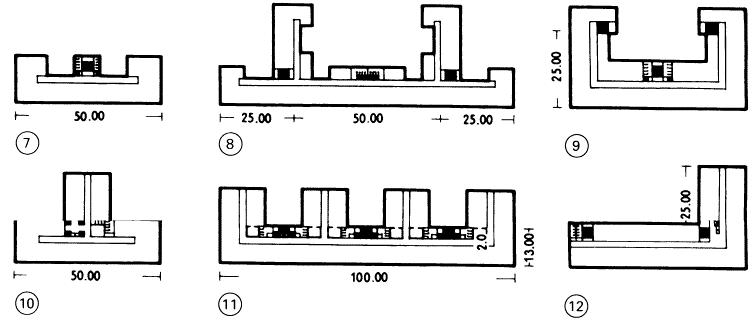Types of Office Space. Systems. Typology
The layout of office space has changed dramatically since the 1950s (1). Working methods are always closely linked to available technology - (2), and the working structure of earlier years is being expanded by modern information technology and office automation. As a result, new forms of floor plan are being generated.


After changing from separate offices in the 1950s, to open-plan concepts after the mid-1960s, and group office principles in the 1970s and 1980s, it seems that a combined office design is becoming established in the 1990s. The first examples appeared in Denmark in 1976, where new space dividers and combinations of all known basic forms were being used.
The orientation of a new office building will depend on location. Where possible, the building should be orientated to admit useful daylight while avoiding glare and solar heat gain. In the USA, the principal axis of 90% of office buildings runs east-west, since deep penetration by morning and evening sun is unpleasant. It is easy to use canopies to block the sun from the south. However, if the primary axis runs north-south, the sunlight can reach every room. In the northern hemisphere, north-facing rooms are justifiable only when the building does not have a corridor.
Systems. A single row of rooms is generally uneconomical, and is only justified for deep office spaces where daylight is a problem (3). A double row of individual small rooms, all with daylight, was previously used in most office buildings - (4). A three-part arrangement is typical of high-rise office buildings - (5). In city centres in the USA, designs without corridors evolved. In some, all rooms (with either natural or artificial lighting) were grouped around a circulation core containing elevators, staircases, ventilation ducts etc.; in others, services were located on the periphery (6).


Outside the city centre, another US system had a large work space in the centre, with sound insulation, ventilation and lighting in the ceiling; small offices with daylight were placed around the edge. These combined offices were used in Scandinavia after the mid- 1970s. As in the US system, the floor plan was normally 16-18m deep. They were also built as a large open-plan office or as separate offices divided into three rows - (7).
Daylight can usually be used up to a distance of 7.00 m from the window. New daylight technology systems (see section on daylight) which convey and change the direction of the light (prisms and reflectors) can make more efficient use of daylight.
A schedule of accommodation is shown - (8) which compares five alternatives in order to obtain quantifiable information about floor area requirements. (1) A standard separate office, 1.25m grid module, three module spaces only. (2) Deluxe separate office, grid module 1.50m, various widths. (3) Open-plan office, room depth 20-30m, floor area up to 1000m2. (4) Group offices for 15-20 employees, workstations no more than 7.50m from the fagade. (5) Combined office, all single rooms approx. 10m2 with a common area 6-8m deep.

Typology. Large office buildings are usually multistorey structures with moveable internal walls. Service cores, containing plumbing, staircases, elevators etc., are generally located at the maximum distances specified by the building regulations. Service cores can be placed at the front of the building - (1)+ (2), to one side within the building - (3) – (5), at interior corners - (6)+ (10) – (12) + (15) + (16), at the end of a passage -> (8),(9), (11), (12), (14) or between corridors next to a light shaft – (17) – (21), in order to maintain the greatest possible length and continuity in working spaces. A simple central rows of columns (1) + (2) allows for a corridor on one side or the other according to space requirements. A double row of columns (3) – (5).


In such cases the corridors may be lit directly by high-level windows and/or by glass doors in the corridor wall. Daylight in the corridor may be provided economically by overhead skylights in buildings with wings – (10) + (11), and those that are short – (13), angled – (12) T-shaped (15) or U-shaped – (16).

Lateral illumination of corridors by recesses is less economical – (7) + (8). On deep, expensive sites it is best to locate corridors, service rooms, archives, toilets and cloakrooms on interior courts or atria – (17) – (20). Elevators and toilets can be located at the interior corners of stairwells. Dark rooms, strong rooms and storage rooms should be in dark areas (10) + (11) + (19).
The area required to connect functional spaces in office buildings is the circulation area. In a closed plan, this is the corridors between rooms; in an open plan, it is the paths through the workstations. Path widths need careful consideration, especially when they are part of an escape route. Disability access considerations include the width of doors and circulation routes, wheelchair turnaround clearances, and the slope and length of ramps, etc.

Fire safety is a primary consideration in the planning of circulation routes, and should be considered at an early stage. The main considerations are the width of escape routes, the distance to be travelled, provision of alternative escape routes and the avoidance of dead-end corridors. The plan must comply with local statutory safety requirements (21).
Date added: 2023-01-05; views: 599;
